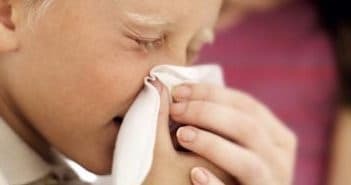
Rhinitis is the inflammatory process of the nasal mucosa, the disease is nothing but a runny nose. More commonly, rhinitis is common among children of all ages. Rhinitis is considered to be a completely innocuous process, however, if rhinitis occurs in early childhood, it can provoke serious consequences and complications. To cure a runny nose in children, you can at home using prescriptions for traditional medicine and official medicines.
How to quickly cure a runny nose at home, you can learn from the content in this article.
Contents of
- 1 Types of rhinitis
- 1 Species of rhinitis
- 2 Features of pediatric rhinitis
- 3 First signs and symptoms
- 4 Diagnosis
- 5 Treatment at home
- 5.1 Folk remedies
- 5.2 Medications
- 6 Possible consequences and complications
- 7 Video
Types of rhinitis
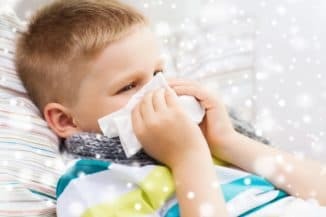 In children rhinitis can take place in an infectious form(most often), in the form of allergic, vasomotor, and also atrophic.
In children rhinitis can take place in an infectious form(most often), in the form of allergic, vasomotor, and also atrophic.
- Infectious( viral) rhinitis .The mucous membrane of the nasal cavity serves as a good entry into the child's body for various kinds of bacteria, staphylococcus and other pathogens. With rhinitis of the infectious type, the mucous membrane swells and swells, a watery secret develops, which gradually thickens, can acquire a purulent character.
- Allergic rhinitis .Sneezing, itchy sensations, serous watery secretion, stuffy nasal cavity, redness of the eyes and tears are a rhinitis of an allergic type, its outbreaks are typical for summer and spring - the flowering period.
- Vasomotor rhinitis .Nasal congestion and secretion of serous secretions, which are intensified by the use of hot food. Occurs after the cure of the common cold, can be observed even in healthy children. Rhinitis of the vasomotor type provokes the atrophic stage with the abuse of vasoconstrictive drugs.
- Atrophic rhinitis .The reason is the same - the excessive use of vasoconstrictor drugs that provoke a constant vasospasm, which eventually breaks the normal state of the mucosa. Characteristic manifestations: dryness and itching, sniffing.
How to cure a runny nose during pregnancy 3 trimester is indicated in this article.
Features of pediatric rhinitis

Even common cold in young children can have serious consequences
Children are more prone to rhinitis: walks, active games, contacts with other children, immune system is not getting stronger - all this can provoke the appearance of a cold. If the disease is not a serious threat for children over the age of seven, in infants and young children may have serious consequences for .
In more complex form, the disease occurs in newborns, since the nasal passages of the child are still rather narrow, and even a small mucosal edema can cause severe nasal congestion, the child becomes difficult to breathe. There are violations of sleep, nutrition, the child becomes moody and restless. That is why it is so important to know how to treat a cold in a newborn baby.
Important! At small children during a dream there can be attacks of a dyspnea or short wind, in serious cases - suffocation, parents are recommended to be near the child, to trace its status.
First signs and symptoms of
 The first signs of rhinitis can not be noticed. Burning and dryness in the nasal cavity, nasal congestion, frequent sneezing indicate the onset of the process. Within a few days, with a cold, there are discharge from the nasal cavity, transparent and dense, gradually they become thicker and acquire a yellow-green hue. Such signs lead to the disappearance of smell, the deterioration of taste perception.
The first signs of rhinitis can not be noticed. Burning and dryness in the nasal cavity, nasal congestion, frequent sneezing indicate the onset of the process. Within a few days, with a cold, there are discharge from the nasal cavity, transparent and dense, gradually they become thicker and acquire a yellow-green hue. Such signs lead to the disappearance of smell, the deterioration of taste perception.
What to do when teary eyes and a runny nose will help to understand this article.
Further rhinitis can be expressed by such symptoms as:
- Headaches of a nicking character.
- Inability to breathe through the nose.
- Increased temperature.
- Redness around the nasal area.
Not cured in time a strong cold in the child provokes abundant secretion of turbid mucus from the nasal cavity, the accumulation of mucus can acquire a purulent character and cause the development of purulent rhinitis or sinusitis.
What folk remedies for the common cold and stuffiness can be and what are the most effective, this article will help to understand.
Important: hypothermia is the main reason provoking nausea in children. Under the influence of hypothermia, protective functions are reduced, and pathogenic bacteria are activated in the oral and nasal cavities. Reduced immunity may also be a consequence of recently transmitted diseases.
Diagnosis

The doctor-otolaryngologist will inspect the nasal passages - the
rhinoscopy. If symptoms of the common cold are found, you should consult an otolaryngologist , after carrying out the necessary diagnostic measures, he will put an accurate diagnosis and prescribe the appropriate treatment for rhinitis. In addition to collecting an anamnesis and analyzing the complaints of a small patient, the following laboratory tests are performed to identify rhinitis:
- Clinical blood and urine tests.
- Inspection of nasal passages - a rhinoscopy.
- Radiographic examination of nasal sinuses.
- Acoustic rhinometry and rhinomanometry.
- Cytogram and histogram of the smear from the nasal mucosa.
- Immunological examination of blood.
How to treat a common cold with folk remedies at home, you can learn from this article.
Home Treatment
Home treatment can be effective if you have had a preliminary consultation with your doctor( especially if you are going to treat a runny nose in an infant!). Self-treatment without an accurate definition of the disease and its kind can not only fail to show a positive result, but also harm the health of the baby.
Folk remedies
 What is the best way to treat a runny nose in a child? Effective folk remedies for the treatment of rhinitis are home drops, proven recipes for their preparation:
What is the best way to treat a runny nose in a child? Effective folk remedies for the treatment of rhinitis are home drops, proven recipes for their preparation:
- Onions and oil. For preparation, the onion fin is finely chopped, fried in a dry frying pan and poured with a small amount of vegetable oil. Onion oil insist all night( hours 8-12), before application necessarily filter. In each nostril, one drop is added, two drops. The recipe is suitable for children from 3 years old. Beetroot and carrots. An alternative to shop drops will be carrot or beet juices, diluted with water in equal proportions. The medicine can be used for children under one year.
- Kalanchoe. The juice of the plant, squeezed from the cut sheet, should be buried in the nostrils, it will be enough from three to five drops. With only a beginning rhinitis in the child, it is enough to lubricate the nasal cavity 2-3 times with the Kalanchoe juice.
- Aloe. No less effective are the drops of aloe juice. Scald two leaves of the plant, squeeze out the juice from them and dilute them in cold water( the water should be boiled) in a ratio of 1:10.Drops are used three to five times a day.
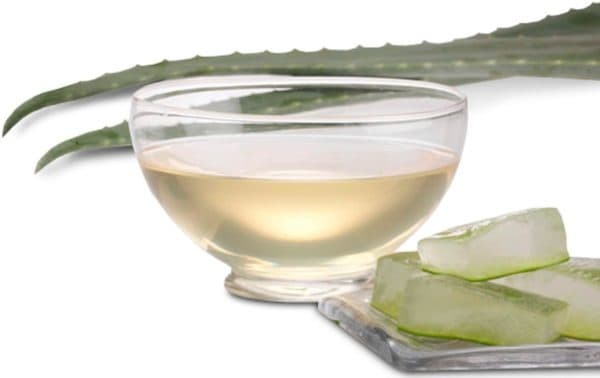
Drops from aloe juice - one of the effective folk remedies for children's colds
For recovery from the common cold, you can apply this recipe: dissolve a teaspoon of salt in a hundred milliliters of clean water, moisten a cotton swab in solution and insert it into each nostril one at a time. The drug quickly and effectively removes the swelling of the mucous membrane.
What folk remedies for allergic rhinitis in adults are best to use, you can learn from the article.
Medicines for topical external application( mixture and ointment):
Mint oil and honey. To prepare the medicine, take two parts of natural honey and add one part of the mint essential oil. The mixture is lubricated by the mucosa of the nasal cavity. 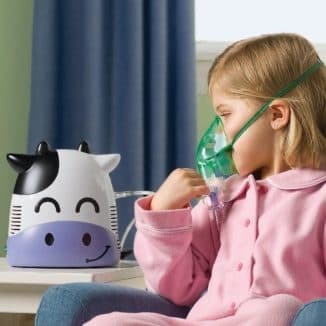 With a cold, inhalations help quickly and effectively, but a positive result can be achieved only if the procedures are performed correctly. Rules:
With a cold, inhalations help quickly and effectively, but a positive result can be achieved only if the procedures are performed correctly. Rules:
- The procedure is carried out no later than one hour before eating.
- The procedure is contraindicated at temperatures above 37.5 degrees.
- Do not expose to fresh air for three hours after the procedure.
- It is necessary to monitor the temperature of water and steam, the value above 40 degrees is not permissible and is fraught with burns.
The inhalation can be carried out in the usual way, using essential oils( fir, pine, mint).Such a procedure is possible for children over three years old. Do not use ethers if the child has an allergy or asthma. In a saucepan with boiled hot water, you need to add a few drops of ether, breathe in pairs with the baby, covering it and your head with a towel.
This article will help to understand how to distinguish an allergic rhinitis from not allergic.
To simplify the procedure, you can use a nebulizer, a special inhaler that has the ability to spray healing solutions into small particles for a more successful penetration into the sinuses of the nose. The inhalation procedure with the device takes ten minutes. The
Recipes of inhalations:
- Pine buds in the amount of one hundred grams, eucalyptus leaves( two spoons), collecting chamomile, St. John's wort, calendula( four spoons) pour two liters of water, ten minutes to keep on low heat. After cooking, persist for about thirty minutes. Preheat before use.
- Take 2 tablespoons of Kalanchoe juice, use in a nebulizer.
- Alkaline solution "Borjomi" is perfect for the procedure.
Medications
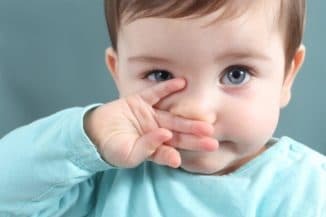 Treatment of rhinitis in children is primarily aimed at cleansing the nasal passages. For this use solutions based on sea salt, for example Aquamaris. In the bacterial nature of rhinitis antibiotics Albutid and Protargol are used, depending on the age, a concentration of 1 to 5% is prescribed. The exact concentration is prescribed by the doctor. Treatment can not do without vasoconstrictive drops( Nazol, Nafazolin, Xylometazoline).To treat a child's rhinitis and prescribe drops in the nose Miramistin.
Treatment of rhinitis in children is primarily aimed at cleansing the nasal passages. For this use solutions based on sea salt, for example Aquamaris. In the bacterial nature of rhinitis antibiotics Albutid and Protargol are used, depending on the age, a concentration of 1 to 5% is prescribed. The exact concentration is prescribed by the doctor. Treatment can not do without vasoconstrictive drops( Nazol, Nafazolin, Xylometazoline).To treat a child's rhinitis and prescribe drops in the nose Miramistin.
To eliminate stasis, use topical preparations( ointments) with eucalyptus oil( Gevkamen, Doctor Mom).
Possible consequences and complications of

Prolonged runny nose can lead to sinusitis, frontitis, etmoiditis, sfenoiditis.
Prolonged course of rhinitis and lack of adequate treatment can lead to complications such as sinusitis, frontalitis, etmoiditis, and sphenoiditis. With high temperature rises, complications can pass to the visual organs and manifest as inflammation of the optic nerve. Prolonged cold in the child may be the cause of meningitis. In children under 5 years, a frequent consequence of rhinitis is otitis - an inflammation of the hearing.
What drops from the allergic rhinitis are best used without harm to health, you can understand reading the article.
Video
Useful video tips on how to avoid the common cold in children and what to treat if it does start:
If the symptoms of rhinitis in the child have been noticed, and all measures for treating the disease are taken on time, successful recovery is guaranteed. Folk remedies and medications used at home will help to recover in a short time.
